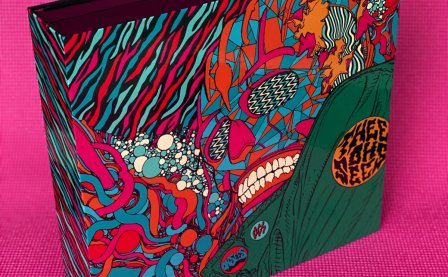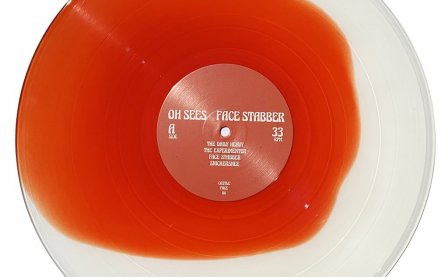Some day, when alien archaeologists are sorting through the layers of trash that will eventually cover and overrun the earth, I wonder what they’ll make of the random ephemera we dub as “art.” A book here, a record there, paintings, photographs, some paintings indistinguishable from photographs, etc. I wonder if they’ll know how to play a record. Maybe they’ll be the ones to have found the Golden Records on either Voyager 1 or 2; maybe they’ll have understood the directions (hahaha), following them like a kid cutting out a mask from a cereal box. Maybe. Maybe then they will piece all of the different metaphors and images we kept returning to: mazes (labyrinths), the human construct that is both an accomplishment and a prison, the sinking ship(s), an obsession with death and eventuality (they’ll probably understand this one), delusion, irony, the floating coffin. <
An argument can be constructed for either case of execution: that the music should either enhance the emotional context and expression of the thematic/metaphorical qualities, or that juxtaposition works as a strength of subversion, the disguise a maze in itself set up before the listener to work their way through to the heart of whatever the fuck it was the artist was trying to express. I’m not sure which one is stronger than the other, but I do believe that establishing a hierarchy between one or the other belittles the extent to which understanding the other is possible. Does this make sense? At first I wanted to criticize Floating Coffin based on a notion that if Thee Oh Sees really wanted to permeate this “darkness” they had so formed, then they should have pushed the sonics away from everything that would be sort of an identifier for the band: the “la la la’s,” the “ha ha ha’s,” and other singable chorus blasters that could be sung by children. But then what would be left as an identifying mark of the band? John Dwyer & Co. have a style distinctly and linguistically their own at this point. Draw whatever parallels you want to various Nuggets bands, but that conversation is old and boring now. Looking at the last four (!) albums released by this band in the last three years, Thee Oh Sees can do full-band captures (this album, Carrion Crawler/The Dream), home 4-tracked goofiness (Castlemania), and studio embracing/fuckery (Putrifiers II), all while retaining the essence of what it is that makes them themselves: those balanced moments between serious and playfulness, the comforts of what we normally expect from the safety of a childish existence not necessarily broken, but rather, the two expectations trying to coexist.
And this brings me to an idea; maybe this is what made “Ring Around The Rosie” such a goddamned success over time. Kids still sing it! I heard one the other day all singing about the bubonic plague, la la la. I hope some kid one day starts singing “Tunnel Time” out loud in front of her/his “cool/hip” parents: “I’ve been cleaning up bodies/ They all look the same to me/ Ha ha ha ha ha.” As Emerson said, “Sorrow makes us all children again.” Ha ha ha, la la la.
In so many ways, this makes sense. Rock ‘n’ roll is now a traditional form, and like other traditional forms, the constant reworking of familiar themes in different times is what ties itself to the moment. Not too surprisingly, the limited LP edition features a flexi-disc with a cover of the traditional song “Balm in Gilead,” sung by Brigid Dawson. “Balm in Gilead” is full of metaphors and ideas taken from a history of sources, the mishmash of an Old Testament reference with a New Testament expression of Salvation. Not to say this spiritual should be compared to the songs of Floating Coffin, but it provides a good backdrop for the idea of working both within and around forms, the most obvious being the floating coffin to that of Melville’s, the maze/tunnels that appear in most of the songs, the relative difference between being below and above the ground.
It’s great to have a thematically consistent and well-executed Thee Oh Sees album. But it’s somewhat surprising as to how well of a grip Thee Oh Sees have here, and although prolificacy may warrant missteps, this doesn’t seem to be the case with this band. As great as garage rock can be, songs about weed, California, and petty relationships get stale quick. Make no mistake; Thee Oh Sees definitely make the kind of music suited towards the id (“I Come From The Mountain” being the most straightforward rock song on the album), but much like all great traditional music forms (and other art before it), the depth comes after the listening, in the afterthoughts left by the song. Foremost, it’s there to make you feel good, even if everything around is as thus: Slayed in Pairs/ What can we do with them?/ I swear I’ll fly right by and exhume/ Fair and scared/ Young and dead in the dust/ I look down and see them looking up.”
More about: Thee Oh Sees




